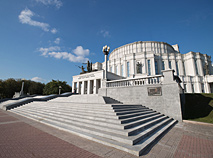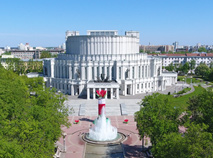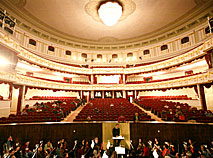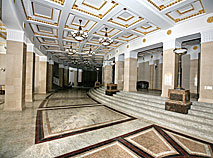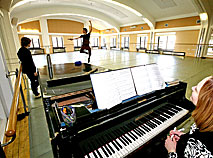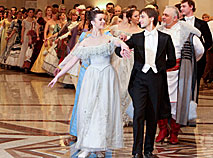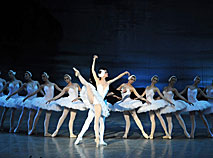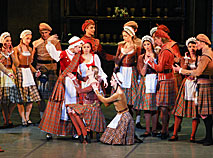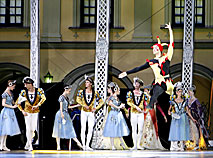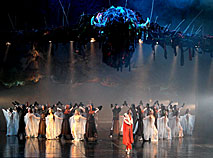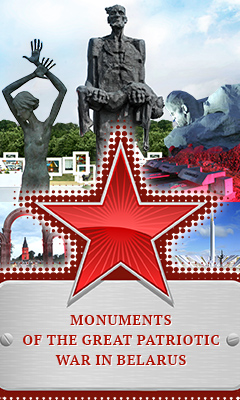Bolshoi Opera and Ballet Theater of Belarus

The National Academic Bolshoi Opera and Ballet Theater of the Republic of Belarus is one of biggest theaters in Europe and the architectural landmark of Minsk.
In 2023 the Bolshoi Theater of Belarus marks 90 years since its founding. The theater has some 20,000 performances and over 200 premieres under its belt.
History of the Bolshoi Opera and Ballet Theater of Belarus
 In the 1920s, Minsk’s first State Drama Theater had several opera soloists, a group of choir singers and ballet dancers and a symphony orchestra. The theater staged music and drama performances, opera and ballet pieces.
In the 1920s, Minsk’s first State Drama Theater had several opera soloists, a group of choir singers and ballet dancers and a symphony orchestra. The theater staged music and drama performances, opera and ballet pieces.
In 1930 Anton Bonachich, an outstanding soloist of the Mariinsky Theater, set up the first State Opera and Ballet Studio in Minsk that would turn into the State Opera and Ballet Theater in 1933.
 The opera Carmen starring outstanding Belarusian singer Larisa Aleksandrovskaya was the theater’s first production.
The opera Carmen starring outstanding Belarusian singer Larisa Aleksandrovskaya was the theater’s first production.
The theater was granted the title “Bolshoi” in 1940 and the title “Academic” in 1964.
From the very first days, the Bolshoi Theater of Belarus has produced the world masterpieces and created the national repertoire.
Bolshoi Theater Building Design
 In the 1930s famous architect Iosif Langbard suggested building a grandiose constructivism-style opera house with numerous sculptures and bas-reliefs.
In the 1930s famous architect Iosif Langbard suggested building a grandiose constructivism-style opera house with numerous sculptures and bas-reliefs.
The design was inspired by Roman amphitheaters, however, the initial plan was revised and several features were changed, with the number of seats reduced down to 1,500.
The new building of the theater was inaugurated in 1939 with a premiere of Yevgeny Tikotsky’s opera Mikhas Padgorny and The Fountain of Bakhchisaray ballet staged by Kasyan Goleyzovsky.
 The theater became really popular when it started staging Belarusian operas and ballets, like In the Forests of Polesie opera by A. Bogatyrev, Mikhas Padgorny opera (2nd edition) by Yevgeny Tikotsky and the first Belarusian ballet Nightingale by Mikhail Kroshner (1939).
The theater became really popular when it started staging Belarusian operas and ballets, like In the Forests of Polesie opera by A. Bogatyrev, Mikhas Padgorny opera (2nd edition) by Yevgeny Tikotsky and the first Belarusian ballet Nightingale by Mikhail Kroshner (1939).
When the Great Patriotic War broke out, the theater was damaged by bombs and was looted. The artists joined the army or were evacuated to the rear where they kept working.
Theater after the War
Soon after the liberation of Minsk from the Nazis, the theater troupe returned to the city and opened the season with the first night of the Alesya opera by Yevgeny Tikotsky in December 1944.
 Meanwhile, the reconstruction of the theater was launched under the supervision of Iosif Langbard.
Meanwhile, the reconstruction of the theater was launched under the supervision of Iosif Langbard.
The new architectural plan envisaged a tier-like design with the hall divided into pit stalls and three narrow boxes. The number of the seats was reduced to 1,200.
For the first time the hall of the theater featured tiered balconies. Andrei Bembel created wonderful settings and decorated the building with plasterwork.
 A picturesque park designed by Iosif Langbard was laid out on the territory surrounding the theater.
A picturesque park designed by Iosif Langbard was laid out on the territory surrounding the theater.
The reconstructed theater opened its doors to the public in 1947, and by 1949 the pre-war repertoire had been restored.
The first nights of the Prince Lake ballet by Vasily Zolotarev and the Kastus Kalinousky opera by Dmitry Lukas (1949) became landmark events in the history of the national theater art of Belarus.
In 1955 the theater staged the first operatic performance for children Marinka.
 The theater's repertoire started to feature the world masterpieces as well as works of Belarusian composers dedicated to the history of our country.
The theater's repertoire started to feature the world masterpieces as well as works of Belarusian composers dedicated to the history of our country.
The calling card of the theater is the national opera and ballet performances: the King Stakh's Wild Hunt opera by Vladimir Soltan (1989) and the Passions (Rogneda) ballet by Belarusian composer Andrei Mdivani directed by Valentin Elizaryev (1993).
Recent renovation of the theater
 2006 saw the launch of the restoration and renovation project under the guidance of architect Anatoly Shabalin. The project was based on photos made in the 1940s-1950s and also Iosif Langbard’s sketches.
2006 saw the launch of the restoration and renovation project under the guidance of architect Anatoly Shabalin. The project was based on photos made in the 1940s-1950s and also Iosif Langbard’s sketches.
The new elements include crystal chandeliers of the 1950s style, gypsum details, ceiling paintings, golden stucco work along with red velvet curtains and drapery. The interior features natural stones, marble and granite. Floors are made from nine kinds of granite and are adorned by ornaments.
Three floors have been added to the building after the renovation. Moreover, the mezzanine floor now accommodates a dressing room and a studio.
 The facade of the theater is adorned by the sculpture of Apollo and two flying nymphs.
The facade of the theater is adorned by the sculpture of Apollo and two flying nymphs.
A light cascade fountain which resembles the silhouette of the theater was installed on the main alley. Two other alleys, the Ballet Alley and the Opera Alley, were added not long ago.
In 2009 the Belarusian President attended the opening ceremony of the theater.
The new Chamber Hall named after Larisa Aleksandrovskaya hosts vocal and instrumental music concerts along with classic one-act and modern operas.
Unique Stage
 Today, the stage of the Bolshoi Theater (597 m2) is an ultramodern transformer consisting of 21 pitches. Each can go up to 4.6 meters above the stage and go down 3.3 meters under, change the slope to create a scenic topography.
Today, the stage of the Bolshoi Theater (597 m2) is an ultramodern transformer consisting of 21 pitches. Each can go up to 4.6 meters above the stage and go down 3.3 meters under, change the slope to create a scenic topography.
There are hatches that are used by artists to suddenly appear or disappear on stage. The stage is also equipped with "flight" devices and the panorama-screen in the background, which gives the illusion of motion.
The "heart" of the theater is the mechanical devices of the stage:
-
a ballet truck with special coating
-
two turning tables and a ring, moving at different speeds and in different directions
-
"treadmill" to create the illusion of motion
For better visibility the stage is tilted 4° to the audience hall, and can be increased by 4 meters.
 The orchestra pit has also been mechanized and may be removed into a special pocket under the stage. The theater has a complex set of ceiling mechanics, which allows changing or setting more than 50 curtains or stage sets.
The orchestra pit has also been mechanized and may be removed into a special pocket under the stage. The theater has a complex set of ceiling mechanics, which allows changing or setting more than 50 curtains or stage sets.
The Bolshoi Theater of Belarus is equipped with the cutting-edge lighting equipment including a set for special effects with the moving image and the system of spot lights (over 400 on the big stage alone).
The theater uses a new air conditioning system developed by Belarusian scientists. This system serves the air not from the ceiling but right under the seats.
Opera and Ballet Theater Today
 Today the repertoire of the Bolshoi Theater of Belarus features about 90 opera and ballet performances. One of the priorities for the theater is to expand the national repertoire. Some productions have been on the theater’s playbill for more than three decades due to their popularity. These, for example, include the Madame Butterfly opera, the ballets Creation of the World and the legendary Spartacus by world-famous choreographer Valentin Elizariev. The new production was shown to mark the 70th anniversary of the Maestro.
Today the repertoire of the Bolshoi Theater of Belarus features about 90 opera and ballet performances. One of the priorities for the theater is to expand the national repertoire. Some productions have been on the theater’s playbill for more than three decades due to their popularity. These, for example, include the Madame Butterfly opera, the ballets Creation of the World and the legendary Spartacus by world-famous choreographer Valentin Elizariev. The new production was shown to mark the 70th anniversary of the Maestro.
The Bolshoi Theater holds annual large-scale cultural projects both on its stage and in other places of Belarus:
-
Opera and Ballet Festival "Evenings of the Bolshoi Theater in the Radziwill Castle" (Nesvizh Castle)
- Ballet Summer in Bolshoi festival
- Minsk International Christmas Opera Forum
- Grand New Year's Eve Ball at the Bolshoi Theater
- Doors Open Day
The theater has opened its branches in Mogilev, Gomel and Novopolotsk. In 2012, it opened a small ballet stage to be used as an experimental workshop for young choreographers and musicians.
 The Bolshoi Theater of Belarus maintains international contacts with the world’s major theaters, including the theaters of Russia, Ukraine, Bulgaria, Azerbaijan, Georgia, Poland, Slovakia and Romania. The theater has been on tours in over 30 countries.
The Bolshoi Theater of Belarus maintains international contacts with the world’s major theaters, including the theaters of Russia, Ukraine, Bulgaria, Azerbaijan, Georgia, Poland, Slovakia and Romania. The theater has been on tours in over 30 countries.
Belarus Bolshoi Theater – World Stage
The Bolshoi Theater of Belarus hosts the world’s best troupes and performers. The recent guests were Saint Petersburg State Academic Ballet Theater of Leonid Yakobson, Tbilisi Z. Paliashvili Opera and Ballet Theater, Eifman Ballet…
 In 2010 Andris Liepa recreated the Firebird and the Scheherazade ballets on the Belarusian stage from Sergei Diaghilev’s legendary Russian Seasons.
In 2010 Andris Liepa recreated the Firebird and the Scheherazade ballets on the Belarusian stage from Sergei Diaghilev’s legendary Russian Seasons.
In 2013, as part of the World Ballet Stars project, soloists of the world-renowned theaters performed the main parts in the best classical (Don Quixote, Corsair, Swan Lake) and contemporary shows.
In 2014 the National Academic Bolshoi Opera and Ballet Theater of the Republic of Belarus was awarded UNESCO's Five Continents medal, the prestigious award for contribution to world culture.
In 2015 Bolshoi joined Opera Europa, the European Association of Opera Companies and Festivals.
Belarus’ Bolshoi Theater Celebrities
Larisa Aleksandrovskaya, a renowned opera artist of Belarus, worked as the art director of the theater in 1951-1960. Her best stage direction is Aida. In 1927 she performed at the World Music Exhibition in Frankfurt-on-Maine, one of the ancestors of the modern Eurovision.
 Valentin Elizariev is an outstanding ballet soloist, ballet master and choreographer who staged more than 30 shows in Belarus and worldwide. In 1986 his show starring Nina Ananiashvili and Andris Liepa won the Grand Prix of the international competition in Jackson. In 1992-2009 Valentin Elizariev worked as the art director of the theater. In 2018 he was re-appointed to this post again.
Valentin Elizariev is an outstanding ballet soloist, ballet master and choreographer who staged more than 30 shows in Belarus and worldwide. In 1986 his show starring Nina Ananiashvili and Andris Liepa won the Grand Prix of the international competition in Jackson. In 1992-2009 Valentin Elizariev worked as the art director of the theater. In 2018 he was re-appointed to this post again.
Honored Artist of Belarus Viktor Skorobogatov is a soloist, producer, creator and head of the Belarusian Capella.
 Nina Sharubina, a singer with a rare voice pattern, is the People’s Artist of Belarus and leading stage performer, holder of Belarus State Prize 2012.
Nina Sharubina, a singer with a rare voice pattern, is the People’s Artist of Belarus and leading stage performer, holder of Belarus State Prize 2012.
Margarita Izvorska-Elizarieva is Belarus’ honored figure of art, producer and art director of the opera theater in 2002-2009.
Doors Open Day at Bolshoi Theater
 A tradition of the annual Doors Open Days began in 2015 when visitors were invited on a backstage tour of the theater for the first time to explore the mystery of creating on-stage masterpieces.
A tradition of the annual Doors Open Days began in 2015 when visitors were invited on a backstage tour of the theater for the first time to explore the mystery of creating on-stage masterpieces.
Doors Open Day offers visitors the unique opportunity to access theater areas not normally open to the public. These are rehearsal rooms, technical facilities of the stage, dressing rooms, wardrobes, storages of theatrical props. Visitors cannot only see the theater life "beyond the curtain" but also try their hands in singing, classical dancing and acting in one of the numerous master classes from the leading actors and filmmakers.
How to get to Belarus Bolshoi Theater
The Bolshoi Theater is situated in Minsk downtown, at 1 Parizhskoi Kommuny Square. The theater is within easy reach by ground transport (Operny Teatr bus stop) and metro (Nemiga station).








 print version
print version make home page
make home page add to bookmarks
add to bookmarks